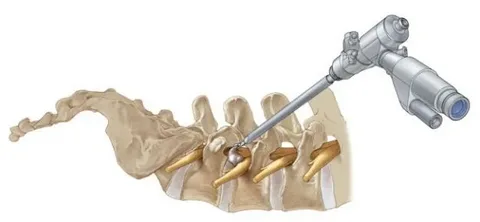A Step-by-Step Look at the Procedure and Precautions
Spine problems mostly occur because of poor posture, aging or Injury. Spine issues are common in athletes and desk workers. After all other treatments fail to reduce pain, spine surgery becomes the last option. Endoscopic spine surgery is upgraded surgery in which patient recovery becomes smoother. So let’s discuss in detail, Is endoscopic spine surgery safe in India? The answer for this question is yes-but safety depends on various factors such as patient selection, surgeon expertise, and the technology used.
Here, we describe endoscopic spine surgery safety step by step and discuss the key precautions. Also discuss the spine surgery cost in India and what advice you should follow after surgery.
Step 1: Accurate Diagnosis and Patient Selection
The foundation of any safe medical procedure is an accurate diagnosis. Endoscopic spine surgery is best suited for conditions like:
- Herniated discs
- Spinal stenosis
- Sciatica
- Degenerative disc disease
A skilled spine specialist will evaluate MRI, CT scans, and X-rays to determine if you’re a candidate for the procedure. Not all spinal conditions are treatable with endoscopy, and misdiagnosis can increase complications.
Patient selection is crucial to safety. Individuals with multiple spinal levels affected or instability may require a different approach. That’s why consulting the best spine surgeon in India-with experience in minimally invasive techniques-is your first safeguard.
Step 2: Preoperative Planning and Risk Assessment
Before the procedure, a thorough health check-up is conducted. This includes:
- Blood work
- ECG and cardiac evaluation (if needed)
- Allergy testing
- Medical history review
These pre-op steps reduce the risks and benefits of endoscopic spine surgery by identifying any underlying issues that could impact the outcome, such as diabetes, hypertension, or bleeding disorders.
The best hospitals for spine surgery treatment in India follow internationally approved safety protocols to ensure patients are fit for surgery and optimize recovery.
Step 3: Use of Advanced Imaging and Surgical Tools
During the surgery, advanced intraoperative imaging (like fluoroscopy or neuronavigation) helps in the precise placement of instruments. This accuracy is a key reason why endoscopic spine surgery safety has improved dramatically over the years.
The actual process involves:
- A small incision (typically less than 1 cm)
- Insertion of a tubular retractor
- Use of an endoscope with a camera and light
- Removal or repair of the damaged spinal tissue
Because the surgeon views the surgical area in real-time and magnified detail, there’s minimal disruption to muscles and soft tissues. This results in a lower spine infection rate and quicker rehabilitation.
Step 4: Highly Skilled Surgeons and Specialized Training
The learning curve for endoscopic spine surgery is steep, which is why experience matters immensely. The best spine surgeon in India will have undergone specialized training in endoscopic techniques and performed hundreds of similar procedures.
Expertise minimizes:
- Nerve injuries
- Incomplete decompression
- Need for revision surgeries
Additionally, experienced surgeons adapt to intraoperative changes swiftly, ensuring patient safety even if unexpected anatomical variations arise.
Step 5: Postoperative Monitoring and Rehabilitation
Endoscopic spine surgery typically allows for same-day discharge or a very short hospital stay. However, safety continues beyond the operating room.
Post-surgery precautions include:
- Monitoring for signs of infection or bleeding
- Guided physiotherapy sessions
- Gradual return to physical activity
- Regular follow-up imaging, if needed
Most patients return to normal life within a few weeks, compared to months with traditional surgery. These outcomes further confirm the minimally invasive spine surgery procedure as a safe and effective alternative.
Understanding the Risks and Benefits of Endoscopic Spine Surgery
As with any medical procedure, there are potential risks. These may include:
- Infection (rare due to small incision)
- Nerve damage (minimized with better visualization)
- Recurrence of symptoms
- Incomplete pain relief
However, the benefits far outweigh the risks when performed under expert care:
- Smaller scar and minimal blood loss
- Shorter hospital stays and faster recovery
- Reduced postoperative pain
- Lower risk of complications in elderly or high-risk patients
Discussing these risks and benefits of endoscopic spine surgery with your surgeon is crucial for setting realistic expectations and making an informed choice.
Why Consider Spine Surgery Treatment in India?
India has emerged as a leading destination for advanced spinal care due to:
- World-class infrastructure
- Cost-effective treatment
- Highly qualified spine specialists
- Minimal waiting time
Patients from across the globe seek spine surgery treatment in India because the outcomes often match or exceed those in Western countries at a fraction of the cost.
Look for hospitals and clinics that specialize in minimally invasive spine surgery procedures and are led by the best spine surgeons in India to ensure the highest standards of safety and success.
Final Thoughts
Because of the latest medical technologies and tools, Endoscopic spine surgery in India becomes the best option for the patients. If spine surgery is performed by an experienced surgeon it will help to get back to normal life faster. For this consult the top spine surgery doctor who can guide you based on your health condition and give best results.







